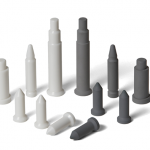Ceramics have been exploited by mankind for over 26,000 years. They have been so central to human engineering that it is impossible to pinpoint a singular origin of the pottery-making process. Archaeologists have coined the term “linear pottery culture” to define the period when ceramics were simultaneously and independently discovered by different peoples across Neolithic Europe. Yet the significance of technical ceramics spans far beyond archaeological curiosity, pervading several key periods of history and every phase of industrial progress into the modern age and the future.
Resolving the Grand Challenges of Engineering with Technical Ceramic Solutions
In a 2008 Google TechTalk, Peter Goldstein – a ceramic engineering specialist – talked at length on the future of advanced ceramics, describing them as “the unsung hero of the materials world”. He highlighted the promise of both oxide and non-oxide technical ceramics in meeting the world’s top engineering challenges in the 21st Century: making sustainable energies economical; engineering the tools of scientific discovery; securing cyberspace; etc. These so-called Grand Challenges have been ratified by the National Academy of Engineering and have attracted interest from some of the world’s brightest minds.
Already, the uptake of technical ceramics in key growth markets is contributing towards true global change and is helping manufacturers meet the Grand Challenges of modern engineering. Technical ceramics are widely used to construct the crucibles used in semiconductor and photovoltaic manufacturing, supporting the concerted global effort to make solar energy sustainable.
Just a few decades ago, it would have been unfeasible to rapidly produce a small, intricate component using a technical ceramic like silicon nitride (Si3N4). Now, manufacturers can quickly prototype millimetre-scale technical ceramic components with extremely complex geometries, following ground-breaking research into lithographic-additive manufacturing (L-AMT) of silicon nitride derivatives known as sialons (silicon-aluminium-oxygen-nitrogen). The potential applications of this technology are theoretically limitless, yet it has already demonstrated outstanding potential in the fabrication of microturbines for efficient energy-generation processes. This is based on the existing success of sialons for electronically- and mechanically-efficient impeller designs.
If we look beyond the current market for technical ceramics, the outlook for their future uptake is even more interesting.

Technical Ceramics in Artificial Intelligence (AI)
Artificial intelligence (AI) once belonged exclusively to the realm of science fiction, but the rise of digital assistants in the smart home devics (Siri, Alexa, etc.) and digital spaces has escalated the debate surrounding AI from a theoretical to a practical conversation. The primary barrier to entry is how power-intensive existing AI programmes are: the human brain consumes just 20 Watts (W), while one of the world’s leading AI programmes – AlphaGo – consumes as much as 250 kilowatts (kW). As a result, AI is currently an unsustainable technology.
Read More: Advanced Ceramic Materials: Fundamental to the Future of AI?
Memory chip manufacturers believe that technical ceramics could be key in unlocking a universal memory that is durable, non-volatile, fast, and low power consumptive. Replacing conventional silicon-based memory chips with advanced ceramics could provide the foundation for sustainable AI.
Internet of Things (IoT) and Technical Ceramics
Technical ceramics can also assist in the growth of device interconnectivity with the advent of 5G and increasingly autonomous devices, from driverless cars to intuitive wearable electronics. One crucial aspect of this push is the application of internet connectivity to a wider range of devices: the so-called internet of things (IoT). An IoT system connects multiple connectable devices wirelessly in a digital, IoT network.
The key niche here is for electro-ceramics, piezo drives, and millimetre scale components with outstanding thermomechanical properties. High frequency communications for increasingly miniaturised devices will require dielectric materials with high-temperature stability and pristine tribological properties, as multiple small-scale components must be integrated into compact modular arrays. Technical ceramics are tipped to excel in such IoT platforms. We explored this in greater depth in another post; Technical Ceramics: Building the Internet of Things.
Industry 4.0 and Technical Ceramics
Each of these niche areas falls under the remit of the proposed fourth industrial revolution (Industry 4.0). As we unlock new capabilities for machines and automation through AI and IoT, we prepare our production lines for a new age of mechanical networking for true smart factory functionality. Technical ceramics are at the forefront of Industry 4.0, assisting with the digital transformation of our essential mechanical processes.
Technical Ceramics from International Syalons
International Syalons is a world leader in technical ceramics design and supply. We provide a choice of material solutions to support the global trend of innovation under the umbrella of Industry 4.0. If you would like any more information, simply contact a member of the International Syalons team today.
References:



